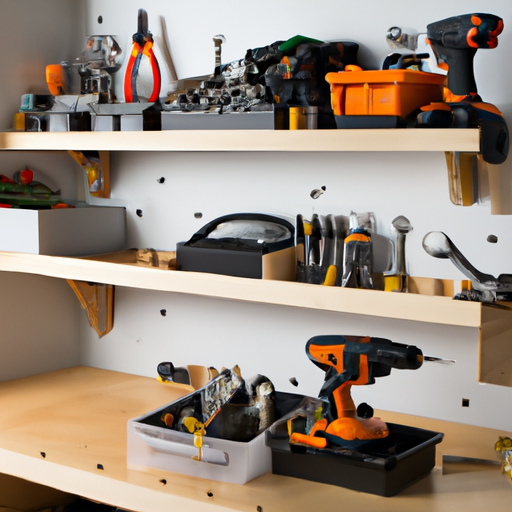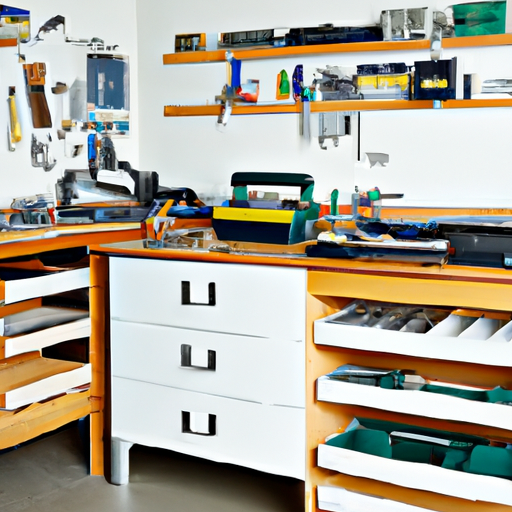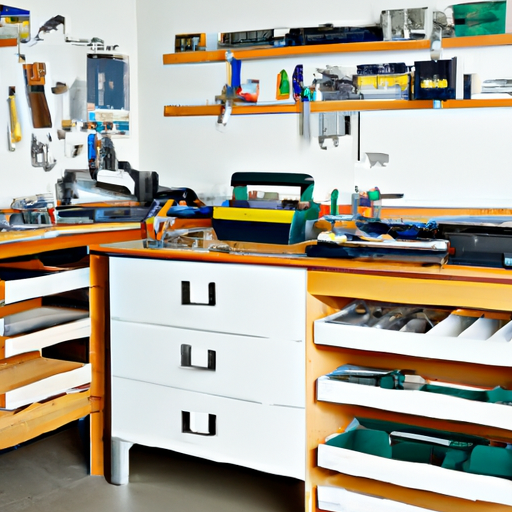In this article, you will discover how to maximize productivity in your home workshop through the use of smart setups. With the rise of remote work and the increasing popularity of DIY projects, creating an efficient and organized workspace has never been more important. From optimizing storage solutions to implementing innovative tools and technologies, this article will provide you with practical tips and ideas to enhance your productivity and make the most out of your home workshop. Whether you are a hobbyist or a professional, these smart setups will revolutionize the way you work and bring your projects to the next level.

1. Organizing Your Space
Having a well-organized workshop is essential for maximizing productivity and efficiency. By creating dedicated zones within your space, you can ensure that tools and materials are easily accessible and that you can work efficiently without wasting time searching for things. When organizing your workshop, consider creating separate zones for different tasks such as woodworking, metalworking, and electronics. This will help you streamline your workflow and keep everything in its proper place.
1.1 Creating Zones
Divide your workshop into different zones based on the tasks you frequently perform. For example, you can have a woodworking zone with a workbench, tools, and storage specifically for woodworking projects. Similarly, you can create separate zones for metalworking, electronics, or any other activities you engage in. By creating dedicated zones, you eliminate the need to constantly move tools and materials around, saving you time and energy.
1.2 Utilizing Wall Space
Make the most of the vertical space in your workshop by installing wall-mounted storage solutions. Pegboards, shelving units, and magnetic strips can provide valuable storage options for frequently used tools and materials. This will not only keep your workspace organized but also free up valuable counter space for your projects. Additionally, having tools within easy reach on the wall will save you the hassle of rummaging through drawers or bins to find what you need.
1.3 Investing in Storage Solutions
Investing in proper storage solutions is crucial for keeping your workshop organized and efficient. Utilize cabinets, drawers, and bins to store tools, hardware, and other materials. Labeling containers and shelves will make it easier for you to locate items quickly and maintain order in your workshop. Consider using clear storage containers to easily see the contents and make it hassle-free to locate specific items when needed.
2. Ergonomic Workstation
Working in a comfortable and ergonomic environment is essential for your overall well-being and productivity. Your workstation should be set up in a way that promotes good posture, reduces strain on your body, and provides optimal lighting.
2.1 Adjusting Workbench Height
Ensure that your workbench is at the correct height to prevent strain on your back, neck, and shoulders. Adjust the height of your workbench so that you can comfortably work without hunching over or reaching too high. This will significantly reduce the risk of developing musculoskeletal disorders and help you work more efficiently.
2.2 Utilizing Proper Lighting
Good lighting is vital for detailed work and reducing eye strain. Position your workbench near a window to take advantage of natural light, and supplement it with task lighting such as adjustable desk lamps or overhead lights with bright, white bulbs. Avoid working in dimly lit areas as it can strain your eyes and affect the quality of your work.
2.3 Incorporating Comfortable Seating
Investing in a comfortable, ergonomic chair is essential for long hours spent working in your workshop. Look for a chair that provides good lumbar support and adjustable features such as height and armrests. This will help prevent fatigue and discomfort, allowing you to focus on your projects for extended periods without compromising your health.
3. Efficient Tool Layout
Organizing your tools in an efficient manner not only saves time but also reduces the risk of accidents. Grouping similar tools together and keeping frequently used ones within reach will streamline your workflow and prevent unnecessary back-and-forth movements.
3.1 Grouping Similar Tools
Organize your tools by category and keep them in designated areas. For example, group all woodworking hand tools together, such as chisels, hammers, and screwdrivers. Similarly, keep all power tools in a separate area. This way, you’ll always know where to find each tool and avoid wasting time searching for them.
3.2 Keeping Frequently Used Tools Within Reach
Identify the tools you use most frequently and keep them easily accessible near your workbench. This may include tools like a tape measure, utility knife, or wrenches. You can use wall-mounted organizers or a dedicated tool tray to keep these tools within arm’s reach. By doing so, you’ll be able to quickly grab what you need and continue working without interruptions.
3.3 Utilizing Tool Shadowing
Using tool shadowing techniques can help you quickly identify missing or misplaced tools. Trace the outline of each tool on a pegboard or foam cutout and hang or place the tools in their designated spots. Not only does this make it easy to see which tools are in use, but it also ensures that each tool is returned to its proper place after use, reducing the chances of misplacing or losing tools.
4. Power Management
Proper power management is crucial in a workshop to ensure a safe and efficient working environment. Installing multiple outlets, utilizing power strips, and labeling and organizing cords are key aspects to consider.
4.1 Installing Multiple Outlets
Having enough electrical outlets in your workshop is essential to avoid overloading circuits and reduce the need for extension cords. Consider installing additional outlets strategically placed around your workspace to accommodate the power needs of your tools. This will minimize the risk of tripping over cords and help maintain a clean and organized work area.
4.2 Utilizing Power Strips
Power strips with surge protection are a convenient and safe way to manage multiple electrical devices. Use power strips to connect and power your various tools and equipment effectively. Label each power strip to easily identify which devices are connected, making it simple to turn off specific equipment when not in use.
4.3 Labeling and Organizing Cords
With multiple tools and equipment, cords can quickly become tangled and messy. Use cable ties or Velcro cord wraps to keep cords neat and organized. Label each cord with the corresponding tool or equipment to avoid confusion and make it easier to unplug specific devices when necessary. Additionally, consider using color-coded labels for different types of cords, further enhancing organization and efficiency in your workshop.

5. Safety Considerations
Safety should be a top priority in any workshop. Implementing safety measures, such as fire safety protocols, proper ventilation, and an organized first aid kit, will ensure a safe working environment.
5.1 Setting Up Fire Safety Measures
Install smoke detectors and fire extinguishers in your workshop to protect against potential fires. Ensure that the fire extinguishers are easily accessible and regularly check that they are in good working condition. In addition, keep flammable materials stored in appropriate containers away from potential ignition sources to prevent accidents.
5.2 Using Proper Ventilation
Proper ventilation is essential for maintaining a healthy and comfortable working environment in your workshop. Install fans or ventilation systems to improve air circulation and remove dust, fumes, and odors that may be generated during your projects. This will help keep you safe and prevent respiratory issues caused by prolonged exposure to harmful particles.
5.3 Organizing First Aid Kit
Accidents and injuries can occur, even in a well-organized workshop. Keep a well-stocked first aid kit easily accessible in case of emergencies. Regularly check and replenish the supplies in your kit, and ensure that all employees or users of the workshop are aware of its location. Being prepared with a properly organized first aid kit can help address minor injuries promptly and effectively.
6. Maximizing Workbench Space
A spacious and well-organized workbench is essential for a productive workshop. By incorporating adjustable clamps, foldable shelves, and drawer organizers, you can make the most of your workbench space and work efficiently.
6.1 Using Adjustable Clamps
Invest in adjustable clamps to securely hold your workpieces in place while you work. Choose clamps that are easy to adjust and provide a firm grip. By using adjustable clamps, you can free up your hands to focus on the task at hand, ensuring precision and efficiency in your work.
6.2 Installing Foldable Shelves
Foldable shelves are a great option for maximizing workspace when not in use. Install shelves that can be easily folded down when not needed, allowing you to reclaim valuable surface area on your workbench. These shelves can be used to store materials, tools, or reference materials and can be quickly unfolded when additional storage space is required.
6.3 Utilizing Drawer Organizers
Make use of drawer organizers to keep small tools, hardware, and accessories neatly stored and easily accessible. Sort items by categories and use dividers or containers to keep everything in its place. This will save you time searching through cluttered drawers and ensure that you can quickly find what you need to complete your projects efficiently.

7. Incorporating Time-Saving Techniques
Efficiency is key when it comes to maximizing productivity in your workshop. By implementing workflow strategies, using automated tools and machines, and setting up assembly line processes, you can significantly reduce the time required to complete tasks.
7.1 Implementing Workflow Strategies
Plan your projects in a way that minimizes unnecessary movements and maximizes efficiency. Think through each step of the process and organize your materials, tools, and work area accordingly. This may involve arranging your tools and materials in the order they will be used or grouping similar tasks together.
7.2 Using Automated Tools and Machines
Investing in automated tools and machines can greatly speed up your workflow. Whether it’s a power tool that automates a manual process or a CNC machine that takes care of precise cutting or shaping, automation can save you time and effort. Evaluate your projects and determine where automation can be beneficial to maximize your productivity.
7.3 Setting Up Assembly Line Process
For projects that involve repetitive tasks, setting up an assembly line process can significantly improve efficiency. Identify the steps that can be standardized and performed by different individuals, if available. By assigning specific tasks to different people or tools, you can streamline the workflow and complete projects in a fraction of the time it would take individually.
8. Utilizing Digital Tools
Incorporating digital tools into your workshop can enhance productivity and accuracy. Workshop management software, digital templates and measurements, and online resources can help streamline your processes and provide valuable information and guidance.
8.1 Utilizing Workshop Management Software
Workshop management software allows you to keep track of inventory, project progress, and scheduling. It can also help with task management, communication, and tracking expenses. Explore different workshop management software options that suit your specific needs to stay organized and efficiently manage your projects.
8.2 Using Digital Templates and Measurements
Digital templates and measurements can save you time and improve the accuracy of your projects. Use computer-aided design (CAD) software or online templates to ensure precise cutting, drilling, or shaping. This eliminates the need for manual measurements and reduces the chances of errors, leading to better results and increased productivity.
8.3 Incorporating Online Resources
The internet offers a vast array of resources that can enhance your knowledge, provide inspiration, and offer tips and tricks for optimizing your workshop. Online forums, tutorial videos, and blogs provide valuable insight from experienced individuals in your field. Take advantage of these resources to continuously learn and improve your skills, ultimately boosting your productivity.

9. Creating a Clean and Tidy Environment
Maintaining cleanliness and organization in your workshop is essential for efficient workflow. By implementing a regular cleaning routine, organizing materials and supplies, and minimizing clutter, you can create a productive and enjoyable working environment.
9.1 Implementing Regular Cleaning Routine
Dedicate time to clean your workshop regularly. Sweep the floors, wipe down surfaces, and remove any dust or debris from tools and equipment. Keep your workstation clutter-free by returning tools to their designated areas after use. A clean and organized environment not only improves productivity but also creates a safer workspace.
9.2 Organizing Materials and Supplies
Take the time to organize your materials and supplies in a systematic manner. Group similar items together and use labeled bins or containers to store them. Keep frequently used materials within easy reach and maintain an inventory system to ensure you are aware of stock levels and can replenish supplies in a timely manner.
9.3 Minimizing Clutter
Clutter can hinder your productivity and increase the risk of accidents. Regularly assess your workspace and remove any unnecessary items or tools that are not in use or do not contribute to your projects. Keep countertops clear and store items in their designated places. By minimizing clutter, you create a visually appealing and functional workspace conducive to productivity.
10. Continuous Improvement
To maintain high levels of productivity in your workshop, it’s important to continually seek feedback, evaluate your workflow, and explore new techniques and technologies. Continuous improvement ensures that you are always finding ways to optimize your processes and stay ahead.
10.1 Seeking Feedback and Suggestions
Regularly seek feedback from coworkers or others who use your workshop space. Their input may provide valuable insights into areas that could be improved or streamlined. Additionally, encourage suggestions for new techniques or tools that can enhance productivity. A collaborative approach fosters a positive working environment and drives continuous improvement.
10.2 Regularly Evaluating Workflow
Take the time to evaluate your workflow periodically. Assess the steps involved in your projects, identify any bottlenecks or areas of inefficiency, and brainstorm solutions to streamline the process. By periodically evaluating your workflow, you can identify areas for improvement and implement changes that will enhance productivity in your workshop.
10.3 Exploring New Techniques and Technologies
Be open to exploring new techniques and technologies that can optimize your workshop. Stay updated with industry trends and advancements, attend workshops and conferences, and network with other professionals. By staying informed, you can identify emerging technologies or innovative techniques that can help you work more efficiently and improve overall productivity.
In conclusion, maximizing productivity in your home workshop requires careful planning, organization, and the implementation of smart setups. By creating dedicated zones, optimizing your workstation, efficiently organizing tools, managing power effectively, ensuring safety, and utilizing digital tools, you can create an environment that fosters productivity and efficiency. Additionally, maintaining a clean and tidy workspace, incorporating time-saving techniques, seeking continuous improvement, and staying open to new techniques and technologies are essential aspects to consider. By following these strategies, you can transform your home workshop into a highly productive space that inspires creativity and allows you to tackle projects with ease.


